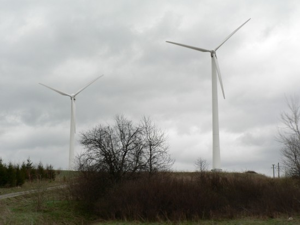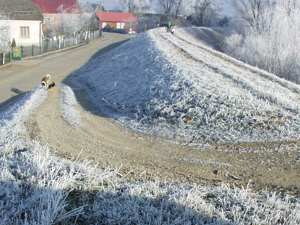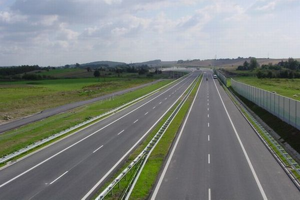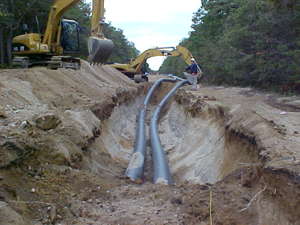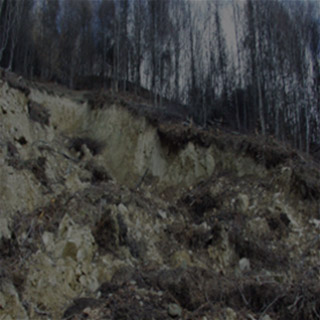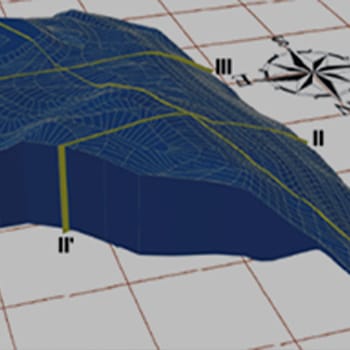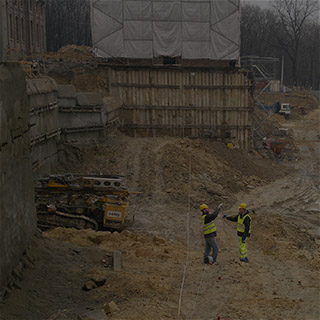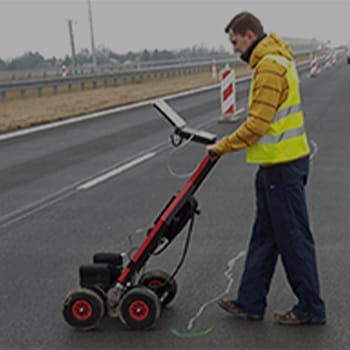ENGINEERING
GEOPHYSICS FOR LINEAR AND LARGE VOLUME CONSTRUCTION
Non-destructive geophysical surveys (NDT) are increasingly being used in areas not related to the exploration and exploitation of mineral deposits, for which they were originally intended. Rapid progress in the construction of geophysical equipment, specialized software and calculation power of computers, gave rise to many new applications of non-invasive geophysical methods.
For several years geophysical methods: geoelectrical, seismic and GPR are indicated in different national regulations, instructions, guidelines as a tool to identify the structure of soils and rocks for the construction industry.
WIND TURBINES
The rapid development of wind energy in Poland since the early 90’s of the XX century led to the need for a thorough exploration of the ground, resulting in an accurate determination of bearing capacity and the foundation for the wind turbines. For this task the most suitable approach are classic drilling or probing with continuous geophysical surveys using seismic MASW and resistivity methods. They are intended to recognize the structure of ground and the presence of zones of subsidence, reduced density, and changes the dynamic modules. The distribution of these parameters in the area covered by the influence of operating wind turbines is possible thanks to a seismic MASW surveys.
COMMUNICATION TUNNELS
Geophysical surveys using refraction and resistivity imaging ERT , are successfully applied in the diagnosis of ground for communication tunnels. Continuous profiling of overburden and bedrock enables to correlate information from the boreholes and also to specify geomechanical parameters and “quality” of the rock mass. These parameters are important in determining the tunnelling technology. Also during the operation of tunnels geophysical seismic survey are used to assess the interaction between the rock massif and tunnel housing. An example is tunnel made in Carpathian flysch formations.
HYDROTECHNICAL STRUCTURES – FLOOD EMBANKMENTS
The problem of the presence of elevated water level condition occurs cyclically with season of intense rainfall and snow melt. In such situations, the flood embankments and dry water reservoirs play very important role. For a thorough analysis of the structure and condition, comprehensive methods of geotechnical studies correlated with continuous, non-invasive geophysical surveys are applied. The most commonly GPR surveys are applied, however, seismic, resistivity and electromagnetic methods are used too.
ROAD TRANSPORT
It is common practice to use geophysical research as a significant addition to the of geological&engineering cross-sections for facilities like highways, ring roads and others. This is particularly important in the design of roads in areas threatened by the occurrence of non-bearing grounds, peats and especially discontinuous deformation related with mining & karstic cavities. They occur in a subsurface related with historical exploitation places (hard coal, lignite, iron, zinc, lead). Unknown shallow exploitation causes real danger for the surface from the mining excavations. Only non-invasive geophysical surveys are able to recognize and identify these threats to their elimination through the backfilling works. Studies in such areas should be carried out i.e. by seismic refraction and eventually other geophysical methods in the equivocal anomalies areas.
RAILWAY TRANSPORT
Geophysical GPR surveys for revitalization, modernization of railway lines are carried out in order to determine thickness of subcrust and any structural changes in the railway embankments. Such studies are very fast, non-invasive and does not require reorganization of railway traffic. Depending on the purpose of the study acquisition is performed in the axes of tracks and roadsides, as classical ground-coupled profiling or with “air-mounted” GPR antennas in the front of locomotive.
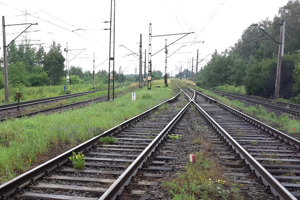
PIPELINES AND HORIZONTAL DIRECTIONAL DRILLING
For the foundation of linear objects such as gas&oil pipelines, aqueducts, frequently are proposed GPR, seismic and resistivity tomography surveys. These methods are useful to refine the geological and engineering interpretation, made between boreholes and probing locations. Geophysical methods are used for continuous separation of geological strata and ascertain the hydrogeological conditions. In case of necessity the HDD to reduce the risk of encountering obstacles below the surface (e.g. boulders) properly designed GPR measurements are carried out. Undoubtedly, the most appropriate geophysical method to determine bedrock is seismic refraction. The choice of the appropriate method or group of methods is dependent on geological conditions, terrain as well as aim of study.
LARGE CONSTRUCTIONS
Increasingly, engineers and designers require the implementation of non-invasive recognition of the ground or during the execution such elements like pillars, foundations, walls, ceilings, floors. Depending on the issue advanced method MASW 2D/3D, microgravity, resistivity or high frequency GPR are applied. These methods are used, among others, in determining areas of weakness and cracks in the substrate under the proposed foundation. They are also used to verify rebar deployment, detect defects within the structure of such panels, floors, and to determine the voids, fissures and zones related with subsidence and suffosion processes.
The above issues require optimal selection and the scope of research. The proposed range of study must take into account many factors such terrain, geology, conditions and the aim of these tests. To obtain reliable results, field work, advanced processing of specialized software and comprehensive interpretation of the results must be performed by a certified, many years experienced staff.



